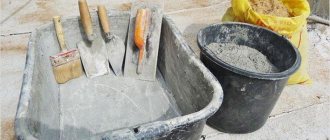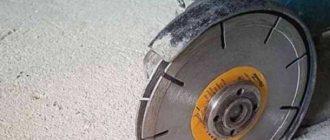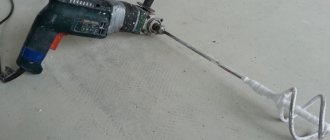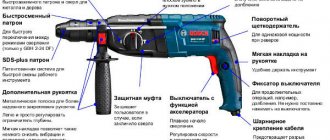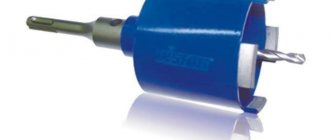Main components and proportions of the mixture
- for M200 the proportions C:P:SH are 1:3:5;
- M300 - 1:2:3.5;
- M400 - 1:1,3:3;
- M450 - 1:1.1:2.5.
The volume of water consumed to prepare the mixture is determined from the ratio of 0.6-1.15 parts of water to 1 part of cement.
The higher the strength required, the less water is added. To mix concrete at the household level, the quantity of components is measured in buckets with a volume of 10-12 liters. For example, you can calculate the proportions of concrete components in buckets for pouring a foundation using the table.
Cement
Cement acts as the main binder in concrete and affects its physical properties. The role of the cement binder is to form a mortar matrix, which serves to evenly distribute the load between large and small filler particles.
The composition of cement includes:
To prepare concrete, cement grades from M200 to M500 (sometimes M600) are used. The numbers in the marking correspond to the minimum compressive strength in kg/cm 2 .
The quality of cement is determined by its shelf life. It is advisable that it be done no later than 3 months ago. When squeezed, it should not form lumps.
Crushed stone
Use crushed granite or gravel. It must be clean. Foreign objects and large pieces should be excluded.
Requirements for the size of granite crushed stone, depending on the purpose of using the solution:
- floor slabs - 5-10 mm;
- foundation for residential buildings - 5-20 mm, for industrial facilities - 20-40 mm;
Crushed gravel is used in the following fractional composition:
- construction and finishing works - 3-10 and 5-20 mm;
- foundation - 40-70 mm.
For the construction of private residential buildings, crushed stone with a particle size of 20-70 mm is usually used. It is introduced into concrete mortar as a coarse filler, which helps improve the strength characteristics of the mixture.
Sand
The purpose of using sand is to reduce cement consumption, fill pores between large fillers, and strengthen concrete.
The water for mixing concrete should not contain dissolved salts, alkalis, or acids. They prevent the mixture from setting and hardening properly. Water cannot be used:
- sewage;
- contaminated with harmful impurities;
- containing plant matter that may decompose;
- which contain oils and organic impurities.
Excipients
Auxiliary substances improve the properties of the concrete mixture. Add to the main ingredients:
If it is expected that the work will be carried out for a long time, substances are added that slow down the setting process.
How long does it take to mix concrete in a concrete mixer?
The time during which the solution must be mixed in a concrete mixer depends on its design and engine power. All these indicators are given in the operating instructions.
The duration of continuous operation without engine overload, depending on the type of concrete mixer, is:
- gravity - 2-2.5 minutes;
- forced type - 1-2 min.
Time is counted from the moment when all the ingredients have been loaded into the mixer drum. Prolonged mixing of concrete is not recommended. This is accompanied by evaporation of water and, accordingly, a decrease in its plasticity characteristics.
Loading order
To obtain a high-quality mixture and prevent mechanical damage to the drum, its components are loaded in the following sequence: cement, sand, crushed stone, water. To correctly load all components into a concrete mixer, adhere to the following algorithm of actions:
- Pour some water into the drum. This will reduce the adhesion of the mixture components to the walls and blades.
- Cement is poured.
- Turn on the concrete mixer and stir until a viscous homogeneous mixture is formed.
- Add sand into the drum, add water, and continue stirring.
- Gravel or crushed stone is laid and auxiliary substances are added.
Some recommend this loading order: first mix all the dry ingredients, pour them into a concrete mixer, and add water. But this loading method complicates mixing of concrete.
Main components of the mixture
High-quality material that meets all requirements can only be obtained if all technological conditions have been met and the proportions of the components have been correctly calculated.
The composition of the mixture may differ by brand depending on additional additives, with the help of which concrete can perform additional functions (increased frost resistance, plasticity, etc.). The standard recipe includes:
- cement;
- sand;
- crushed stone;
- water.
*Explanations for the calculator
- The calculator can calculate the volume for both whole numbers and fractions. Example: volume of concrete 3m 3, volume of concrete 50 l (0.05 m 3).
- If your crushed stone has a mixed fraction of 5-20mm, then you need to select the maximum fraction, that is, 20mm.
- Superplasticizer S-3 (Dofen, SP-1, SP-3) is used in the calculator in dry form. If you use a superplasticizer in liquid form, then you need to independently recalculate the dry substance of the additive.
- When calculating 1 batch in a container with vertical loading (bucket, trough, box, etc.), the yield coefficient of the concrete mixture is used according to the bulk density of the components.
- When calculating 1 batch in a concrete mixer, the average yield coefficient of the concrete mixture is used, calculated from a sample collected from real mixing data in concrete mixers of different nominal volumes.
- If the number of batches turns out to be more than 1, then the number of components for the last batch is calculated independently according to the calculated proportions. (The calculation of the components for the last batch can also be done in a calculator if necessary. Please write in the comments if this is really necessary).
The ratio of components in concrete
| Brand and class | Ratio, kg | Concrete yield from a cement bucket, l | ||
| cement | sand | crushed stone | ||
| M100 V7.5 | 1 | 4,6 | 7 | 78 |
| M150 V12.5 | 1 | 3,5 | 5,7 | 64 |
| M200 B15 | 1 | 2,8 | 4,8 | 54 |
| M250 B20 | 1 | 2,1 | 3,9 | 43 |
| M300 V22.5 | 1 | 1,9 | 3,7 | 41 |
| M350 B25 | 1 | 1,6 | 2,7 | 38 |
| M400 B30 | 1 | 1,2 | 2,7 | 31 |
| M450 B35 | 1 | 1,1 | 2,5 | 29 |
Kawabanga!
Do-it-yourself washed concrete at home - technology features: Review Proportions of concrete in buckets
When preparing the mixture in a concrete mixer with your own hands, use a 10-liter bucket, which serves as a convenient measuring container.
| Brand and class | Cement in bags of 50 kg, pcs. | Proportions in buckets | ||
| Sand | Crushed stone | water | ||
| M200 B15 | 1 | 6 | 14 | 4 |
| M250 B20 | 1 | 5 | 12 | 3,5 |
All components occupy different volumetric masses in the bucket: cement - 15 kg, sand - 19 kg, crushed stone - 17.5 kg.
Proportions of ASG and cement when preparing concrete
Sand and gravel mixtures are often used as solid aggregate. Based on the percentage of gravel in their composition, they are divided into 2 groups:
- PGS (natural) – 10-20%;
- OPGS (sorted) – 15-75%.
For work requiring increased strength of building structures, bulk mixtures of sand and gravel of sea or river origin are used.
| Concrete grade | Proportions, kg | Ratio, l | ||
| PGS | Cement M400 | PGS | Cement M400 | |
| 100 | 1 | 11,6 | 10 | 102 |
| 150 | 1 | 9,2 | 10 | 82 |
| 200 | 1 | 7,6 | 10 | 67 |
| 250 | 1 | 6 | 10 | 53 |
| 300 | 1 | 5,6 | 10 | 49 |
| 400 | 1 | 3,9 | 10 | 35 |
| 500 | 1 | 3,6 | 10 | 32 |
Tips and tricks for making concrete in a concrete mixer
1. When purchasing cement, always pay attention to the production date, since its activity decreases over time. When clenched into a fist, fresh powder easily spills through your fingers, and old powder turns into a lump.
2. It is best to choose river sand with a fraction of 1.5-5 mm. It is well washed and does not contain impurities (unlike quarry).
3. When making durable concrete, it is better to choose gravel (or crushed stone) with particles of different fractions as a solid aggregate. This ensures their tight fit and the absence of large voids.
4. It is convenient to store dry aggregates (sand, gravel, crushed stone) in bulk next to the concrete mixer. It is better to lay a tarpaulin or thick oilcloth underneath. If bulk materials are simply laid on the ground, then it is not recommended to use lower layers.
5. The concrete mixture hardens quickly. Therefore, after preparation, it must be used within half an hour. The hardened composition should not be diluted with water - this will impair its quality.
6. If the proportions of water are violated, the solution may turn out to be too liquid and fragile. After drying, cracks appear on it. Ideal home-made concrete has the consistency of curd mass.
7. If production takes place in frosty weather, then it is better to heat the water.
Tips and tricks for making the mixture
- When making concrete at home, they use precise technology. To make the composition strong and durable, you cannot ignore the nuances:
- If errors were made when pouring concrete, voids will form in the finished material. To prevent this from happening, a special vibrator is used.
- To pour a strip foundation, select grades of concrete higher than M200.
- Pouring concrete at low temperatures is not recommended. Otherwise, weather conditions will destroy the structure of the composition, which will have a detrimental effect on the quality of the finished object.
- If pouring is carried out at high temperatures, the concrete should be moistened for 10-14 days after pouring. Otherwise, cracks will form on the surface.
When building a house yourself, you have to prepare the concrete composition at home. To make the structure durable, you should adhere to clear recommendations, accurately calculate the components and follow the loading sequence. Don't be afraid to mix ingredients and pour concrete, even if you have no construction experience! If you take this task carefully, you will end up with a strong and durable structure.
A properly prepared concrete solution at home means precise adherence to the proportions of substances, proper preparation and adherence to mixing technology, and uniform distribution of components in the liquid mixture. Manual mixing of the solution will not give such homogeneity as preparing concrete in a concrete mixer. This method is used when preparing large volumes of mortar - for the construction of a foundation, when laying the walls of a house, for the manufacture of floor slabs.
How to mix concrete in a concrete mixer
Operating principle and advantages
I think you already understand how concrete mixers work and how to mix concrete in them. Let's summarize:
- in some, only the blades rotate, and the drum itself is motionless (forced type of machines);
- and for others, the drum itself rotates on which the blades are mounted (these are gravitational mixers).
Next I will describe the advantages of each type of mixers. For convenience, we will make a table.
If there is a question of quality and you need to mix a lot of cement, think about a forced aggregate. In this case, a machine with a vertical shaft is recommended; it has fewer problems with unloading the solution.
Proportions of components and operating procedure
It seems that the components have been sorted out. Now it’s time for their number. That is, we will find out what rules and proportions must be observed to prepare concrete for one purpose or another.
First, I will say (or remind you) that concrete is divided into grades based on strength. And each type of strength is used for specific purposes.
The average proportions of concrete in parts look like this: 1:3:5. This means that for 1 part of cement there are 3 parts of sand and 5 parts of crushed stone. Practical builders say that it is more reliable to use the formula 1:2:4.
The proportions of substances for the foundation consist of the following ratio: 8 parts OPGS, 1 part Portland cement, 0.5 parts water. By the way, you can measure proportions in shovels or buckets.
Please note that at one time in a concrete mixer you can mix a solution with a volume of 2/3 of the total size of the tank:
- In a 160 liter concrete mixer you can make 120 liters of solution at a time.
- For a concrete mixer of 180 liters, you need to calculate the number of components so that the total volume does not exceed 140 liters.
If you count in buckets, then for 1 batch in concrete containers with a volume of 150-180 liters you need to put 1 bucket of cement, 2 buckets of sand, 4 buckets of gravel and half a bucket of water.
To avoid overdoing it with water, do a test batch. Do not pour all the water at once. Pour in 2/3 of the intended volume and then gradually add as needed. This way you can choose the optimal quantity.
If you have read the instructions for mixers, then you know that it describes the operating procedure and the sequence of laying out the components. Don't ignore this point, it's really very important.
In general, before starting work, if the machine is completely new or has been idle for a long time, carry out preparations. Check the lubrication on the mechanical elements, turn the mechanism at idle, make sure there are no extraneous sounds.
The loading order itself looks like this:
Wait 1-2 minutes between loading components.
How to make the right choice of concrete mixer
Before deciding on the choice of unit, you need to calculate the required amount of required material using the following formulas:
- strip length (m) × strip section (m2) = amount of concrete needed for strip foundation (m3).
- strip length 1 (m) × section 1 (m2) + length 2 (m) × section 2 (m2) + strip length 3 (m) × section 3 (m2) = amount of concrete for strip foundations with different sections (m3).
- slab length (m) × slab width (m) × slab height (m) = amount of concrete for slab foundation (m3).
- room area (m2) × screed thickness (m) = calculation of concrete for pouring the floor screed (m3).
Drum Capacity Determination
Of course, to build a not very large car - a garage and a bulky country house with a swimming pool - you need different amounts of concrete, which means you will need different concrete mixers. The volume of concrete in a concrete mixer for various works should be (cubes):
- For small pets - 0.18, 0.125, 0.165.
- For large-scale construction, it is more correct to choose up to 0.3.
To build a private building, you need to know exactly how many cubes of concrete there should be in a concrete mixer for effective work. This figure is approximately → 90-150l.
For high-quality mixing and avoiding overloads, the size of the finished mixture should be 2/3 of the tank. The mixing procedure according to the more common gravitational scheme involves an oblique position of the drum, and it is impossible to fill it to the brim. The volume of concrete should not be higher than 2/3 of the total capacity - for example, for a concrete mixer with a 120 liter drum. it will be approximately → 80 l.:
- How much concrete in a concrete mixer is needed to build a garage - up to 22 kilograms, capacity - up to 100 liters.
- One-story buildings, bathhouse: capacity of the concrete mixer - 100-150 liters, weight - from 40 kilograms.
- Buildings with 2 and 3 floors: size - 150-300 liters, weight - from 48 kilograms.
To calculate how many cubes are in a concrete mixer, and what volume the tank should be, the amount of mixture must be taken with a reserve of approximately 10-15%.
Engine power determination
A parameter such as motor power affects the ability of the unit to knead large or heavy fractions at the proper level. The main thing is to understand the correct match between the capacity and power of the motor used. All “home” representatives operating from a 220V network are equipped with motors - up to 1 kW. More powerful units operate at 380V. For constant kneading, 12 hours, 150-800 W is enough. For production around the clock - more than 1000 W. For individual construction, a device with a power of 700V, with a tank size of 120 liters, is sufficient.
A common mistake is that an inexperienced consumer purchases modifications with the maximum permissible value. As a result, construction costs significantly more due to high energy costs.
Final installation choice
Electric drive – power is supplied from 220 V; such mixers are easy to operate and can be used in confined spaces.
ICE (diesel fuel) - from an internal combustion engine. These installations are independent and do not require external power, which makes it possible to use them, including in complete isolation from civilization. Fuel is more expensive than electricity, and the resulting exhaust gases make it possible to use them only in open areas.
Domestic concrete mixers stand out for their quality. Although they are clumsily manufactured, the key components used for assembly are of good quality. The warranty must be at least two years.
How much concrete can you mix with a concrete mixer in a day?
How many? Controversial issue. Because it may even depend on your mood. But suppose you are ready to work all day without a break. Let's see what else the yield of a useful product depends on and calculate:
- Depending on the volume of the pear (sometimes 45, 60, 120, 160, 180 l).
- Engine power (that is, how quickly the machine mixes one portion and how long it can work without interruption).
- Human factor (how quickly the mixture is loaded and unloaded).
Kawabanga! How to make an antifreeze additive for concrete
There is a simple calculation algorithm. If you're interested, you can do the math. To do this you need the following numbers:
Now we calculate: we multiply the time that you are ready to work by “the amount of concrete produced in 1 hour.” So how? On average it should be 3 cubic meters per day.
Forced action concrete mixer and gravity unit
There are no fundamental differences in the order of mixing the solution in these machines. The only difference is in the operating principle of the units. The forced one actively mixes with blades, and the gravitational one uses the rotation of the drum itself and the force of universal gravity.
The main thing here is to take the right time. The forced one does its job 2 times faster.
The forced-type concrete mixer has different sizes and modifications:
- rotary;
- cascade:
- planetary.
The ratio of components in concrete
| Brand and class | Ratio, kg | Concrete yield from a cement bucket, l | ||
| cement | sand | crushed stone | ||
| M100 V7.5 | 1 | 4,6 | 7 | 78 |
| M150 V12.5 | 1 | 3,5 | 5,7 | 64 |
| M200 B15 | 1 | 2,8 | 4,8 | 54 |
| M250 B20 | 1 | 2,1 | 3,9 | 43 |
| M300 V22.5 | 1 | 1,9 | 3,7 | 41 |
| M350 B25 | 1 | 1,6 | 2,7 | 38 |
| M400 B30 | 1 | 1,2 | 2,7 | 31 |
| M450 B35 | 1 | 1,1 | 2,5 | 29 |
Proportions of concrete in buckets
When preparing the mixture in a concrete mixer with your own hands, use a 10-liter bucket, which serves as a convenient measuring container.
| Brand and class | Cement in bags of 50 kg, pcs. | Proportions in buckets | ||
| Sand | Crushed stone | water | ||
| M200 B15 | 1 | 6 | 14 | 4 |
| M250 B20 | 1 | 5 | 12 | 3,5 |
All components occupy different volumetric masses in the bucket: cement - 15 kg, sand - 19 kg, crushed stone - 17.5 kg.
Proportions of ASG and cement when preparing concrete
Sand and gravel mixtures are often used as solid aggregate. Based on the percentage of gravel in their composition, they are divided into 2 groups:
- PGS (natural) – 10-20%;
- OPGS (sorted) – 15-75%.
For work requiring increased strength of building structures, bulk mixtures of sand and gravel of sea or river origin are used.
| Concrete grade | Proportions, kg | Ratio, l | ||
| PGS | Cement M400 | PGS | Cement M400 | |
| 100 | 1 | 11,6 | 10 | 102 |
| 150 | 1 | 9,2 | 10 | 82 |
| 200 | 1 | 7,6 | 10 | 67 |
| 250 | 1 | 6 | 10 | 53 |
| 300 | 1 | 5,6 | 10 | 49 |
| 400 | 1 | 3,9 | 10 | 35 |
| 500 | 1 | 3,6 | 10 | 32 |
Tips and tricks for making concrete in a concrete mixer
1. When purchasing cement, always pay attention to the production date, since its activity decreases over time. When clenched into a fist, fresh powder easily spills through your fingers, and old powder turns into a lump.
2. It is best to choose river sand with a fraction of 1.5-5 mm. It is well washed and does not contain impurities (unlike quarry).
3. When making durable concrete, it is better to choose gravel (or crushed stone) with particles of different fractions as a solid aggregate. This ensures their tight fit and the absence of large voids.
4. It is convenient to store dry aggregates (sand, gravel, crushed stone) in bulk next to the concrete mixer. It is better to lay a tarpaulin or thick oilcloth underneath. If bulk materials are simply laid on the ground, then it is not recommended to use lower layers.
5. The concrete mixture hardens quickly. Therefore, after preparation, it must be used within half an hour. The hardened composition should not be diluted with water - this will impair its quality.
6. If the proportions of water are violated, the solution may turn out to be too liquid and fragile. After drying, cracks appear on it. Ideal home-made concrete has the consistency of curd mass.
7. If production takes place in frosty weather, then it is better to heat the water.
A concrete mixer is a construction equipment designed to prepare a homogeneous concrete mixture.
First you need to differentiate between concrete and cement, because... They are used for completely different needs. Their structural component differs only in the presence of crushed stone (there is none in cement), but in practice there are differences.
Concrete is necessary when pouring foundations, columns and other elements more than 2 cm in thickness.
Brand - load-bearing capacity in the ratio kgcm², i.e. M300 means that 1 cm² can support up to 300 kg.
The composition includes up to 4 components: cement, sand, gravel and water, and many companies sell sand and gravel mixture (SGM), which is immediately mixed in the optimal ratio. Sand and cement must be washed before use.
Table of application of cement mortars.
Sand is the main impurity, and its granules come in different sizes, which significantly affects the final result. Large sand granules can partially compensate for cement, but not more than 7-10%, so you cannot rely on this factor.
Kawabanga! Mini-factory for the production of aerated concrete blocks - how to start your own business
Gravel is a coarse aggregate that directly affects strength properties, as well as the consumed volume of other additives. Necessary for pouring massive durable products.
Water - only drinking water is used, without garbage, so as not to harm the solution. Usually required in small quantities.
Return to contents
Mixing options and order
Proportions of concrete components.
If it is not concrete that is being prepared, but cement, then the ratio of sand, cement and water will be 2:1:0.8.
But the industrial version is much more complicated, because... requires more precision:
It is worth remembering that even in those places where high quality results are not required (M100 is enough), it is better to overpay a little, but make the most durable design possible.
It is thanks to the high grade and durable construction that the foundations can withstand the pressure of heaving soils, seasonal frosts, flooding and other adversities.
Types of concrete mixers and operating principle
The standard technology for preparing concrete in a concrete mixer involves the use of two types of units:
In a direct mixer, dry substances are mixed in a stationary tank, inside of which rotating blades are installed;
Gravity concrete mixers are a rotating pear-shaped or cylindrical tank with a hatch for loading aggregates and unloading liquid concrete solution. The tank is mounted on a metal frame, has its own drive and internal blades. The axis of the tank can change its position to use gravitational forces for mixing.
Mixer circuit
Concrete mixers are also classified by displacement. Compact mixers have a tank ≤60 liters, stationary devices ≥ 1000 liters.
Since during the first mixing the liquid mixture sticks to the walls of the tank and to the shovel, the volume of dry substances must be increased by 10%. Subsequent batches are carried out without a supply of components.
The standard concrete mix is two parts Portland cement, four parts clean sand, eight parts gravel or crushed stone, one part water. Portland cement M 400 is used, the result is concrete B 20; when using cement grade M 500, the concrete will receive class B 25.
Before preparing the liquid mixture, the concrete mixer is installed on a flat horizontal platform; all supports must be firmly on the ground so that during operation there is no danger of the device tipping over.
Different options for preparing concrete
After preparing the solution, the unit and tools must be washed. If the concrete has already hardened, you will need to disassemble the unit. A quick solution is to load broken bricks or construction waste into the tank: hard stones will break the concrete quickly, but after a few dozen such operations the concrete mixer will also become unusable.
How to properly mix concrete in a concrete mixer - step-by-step diagram
Step 1: Installation of concrete mixer
Step 2: Download Components
Step 3: Mixing
Step 4: Unloading concrete and cleaning the unit
- Author: Manager Andrey
(7 votes, average: 4.3 out of 5)
To solve this problem, there are special counting methods. We will turn to them.
The most common grades of cement are M400 and M500. Sand is best used with grains no larger than 2.5 mm in diameter. Crushed stone is used in fractions of 5-20 mm.
For the above parameters we will provide the necessary numbers.
Number of components for preparing a cubic meter of concrete
So, the following amount of materials will be required. If you use M400 cement, then for 1m3 of concrete you need:
- 338 kg cement
- 642 kg sand
- 1250 kg crushed stone
- 170 l water
If the cement is grade M500, then you will need:
- 292 kg cement
- 702 kg sand
- 1258 kg crushed stone
- 146 liters of water
After translation, the following values were obtained.
When using M400 cement you need:
- 281 liters of cement
- 445 l sand
- 781 l crushed stone
When using cement M500 it is necessary:
- 243 liters of cement
- 487 l sand
- 786 l crushed stone
Number of components for volume-specific concrete mixers in buckets
70 l concrete mixer
For cement M400:
- Cement - 1.1
- Sand - 1.8
- Crushed stone - 3.1
- Water - 0.7
For cement M500
- Cement - 1
- Sand - 2
- Crushed stone - 3.1
- Water - 0.6
Concrete mixer 100 l
For cement M400:
- Cement - 1.5
- Sand - 2.5
- Crushed stone - 4.3
- Water - 1
For cement M500
- Cement - 1.3
- Sand - 2.7
- Crushed stone - 4.3
- Water - 0.8
Concrete mixer 120 l
For cement M400:
- Cement - 1.8
- Sand - 3
- Crushed stone - 5
- Water - 1.1
For cement M500
- Cement - 1.6
- Sand - 3.2
- Crushed stone - 5
- Water - 1
Concrete mixer 140 l
For cement M400:
- Cement - 2.2
- Sand - 3.5
- Crushed stone - 6
- Water - 1.3
For cement M500
- Cement - 1.8
- Sand - 3.7
- Crushed stone - 6
- Water - 1.1
Concrete mixer 160 l
For cement M400:
- Cement - 2.5
- Sand - 4
- Crushed stone - 7
- Water - 1.5
For cement M500
- Cement - 2.1
- Sand - 4.3
- Crushed stone - 7
- Water - 1.3
Concrete mixer 180 l
For cement M400:
- Cement - 2.8
- Sand - 4.5
- Crushed stone - 7.7
- Water - 1.7
For cement M500
- Cement - 2.5
- Sand - 4.8
- Crushed stone - 7.8
- Water - 1.5
Concrete mixer 200 l
For cement M400:
- Cement - 3
- Sand – 5
- Crushed stone - 8.5
- Water - 1.9
For cement M500
- Cement - 2.7
- Sand - 5.5
- Crushed stone - 8.7
- Water - 1.6
Concrete mixer 220 l
For cement M400:
- Cement - 3.5
- Sand - 5.3
- Crushed stone - 9.5
- Water - 2
For cement M500
- Cement - 3
- Sand - 6
- Crushed stone - 9.5
- Water - 1.8
Concrete mixer 250 l
For cement M400:
- Cement - 3.8
- Sand - 6.1
- Crushed stone - 10.7
- Water - 2.3
For cement M500
- Cement - 3.3
- Sand - 6.7
- Crushed stone - 10.8
- Water - 2
Other nuances
Construction of a concrete mixer
The impressive weight of a stationary installation requires some effort to transport it. A small volume concrete mixer weighs much less than a larger unit. Therefore, in the absence of assistants, it is necessary to choose an installation on wheels.
Having figured out how much volume of a concrete mixer is required to perform certain jobs, you need to determine the optimal number of revolutions. This parameter affects the performance of the equipment.
In everyday life, concrete mixers are most often used, in which the number of revolutions does not exceed 28 per minute. Increasing the drum speed allows you to get a solution that will set much faster.
Video on the topic: Mixing the solution
Publications on the topic
Rating of Russian-made concrete mixers
The amount of cement in 1 cube of concrete is an indicator that determines the quality of the finished solution
Determining the proportions of concrete in buckets for a concrete mixer
